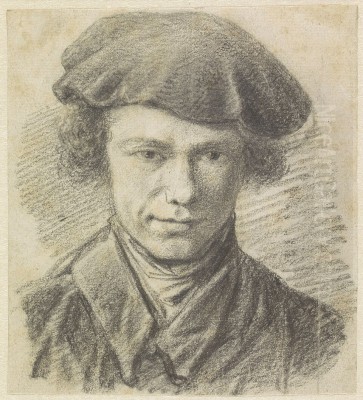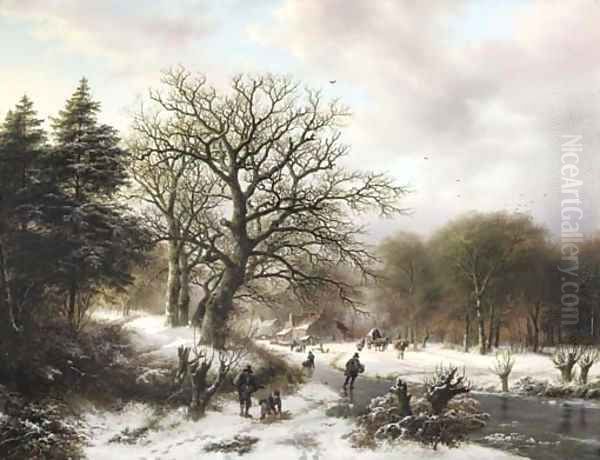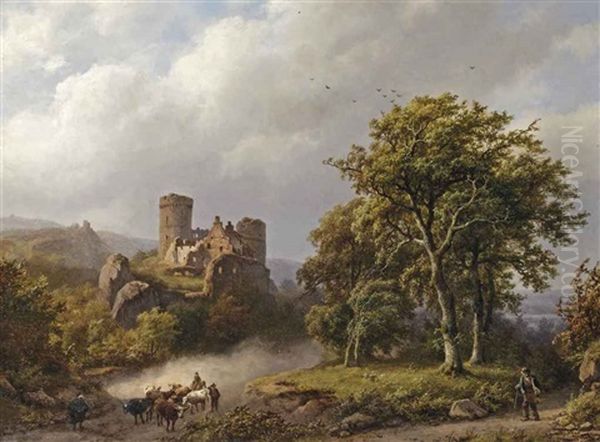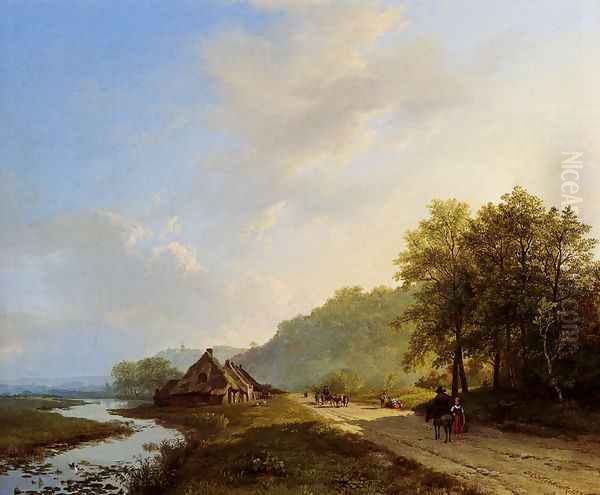
Barend Cornelis Koekkoek stands as a towering figure in the history of Dutch art, particularly celebrated as the most accomplished landscape painter of the Dutch Romantic era. His exceptional skill, sensitivity to nature, and ability to capture both the grandeur and the intimate details of the natural world earned him the affectionate and respectful title "Prince of Landscape Painting" during his lifetime, a reputation that endures to this day. His work represents a pinnacle of Romantic landscape art, blending meticulous observation with a deeply felt emotional response to the environment.
An Artistic Heritage and Early Formation
Born on October 11, 1803, in the coastal town of Middelburg, Zeeland, Barend Cornelis Koekkoek was destined for a life in art. He hailed from a veritable dynasty of painters. His father, Johannes Hermanus Koekkoek, was a distinguished painter specializing in marine subjects, renowned for his depictions of ships and seascapes. Artistry ran deep in the family, as Barend's brothers, including Hermanus Koekkoek Jr. and Marinus Adrianus Koekkoek, also pursued successful careers as painters, contributing to the family's significant artistic legacy in the Netherlands.
Immersed in this creative environment from birth, Koekkoek's formal artistic education began early. At the age of thirteen, he enrolled in the Middelburg Drawing School (Teeken-Academie). His talent was evident, and in 1822, he sought advanced training at the prestigious Royal Academy of Fine Arts (Koninklijke Academie van Beeldende Kunsten) in Amsterdam. There, he studied under prominent artists of the time, including Jan Willem Pieneman, known for his historical paintings and portraits, and Jean Augustin Daiwaille, a respected portraitist and landscape painter who would later become his father-in-law.
Koekkoek quickly distinguished himself at the Academy. His burgeoning talent was recognized, and his early works began to attract attention. In 1833, his promise was further affirmed when he received a prestigious government scholarship, the Felix Meritis prize, which enabled him to travel and further hone his skills. These travels, particularly through the landscapes of the Netherlands and, crucially, Germany, were formative, exposing him to diverse natural scenery that would profoundly influence his artistic direction.
The Call of the Romantic Landscape

Koekkoek's artistic soul resonated deeply with the ideals of Romanticism, a movement sweeping across Europe that emphasized emotion, individualism, and the sublime power of nature. While he initially painted the familiar Dutch countryside, he felt its flat terrain and relatively subdued character did not fully satisfy his Romantic yearning for more dramatic and imposing scenery. He articulated this sentiment in his book of memoirs and advice, Herinneringen en Mededeelingen van eenen Landschapsschilder (Recollections and Communications of a Landscape Painter), published in 1841.
Seeking landscapes that offered greater visual drama – rolling hills, dense forests, majestic trees, and picturesque ruins – Koekkoek traveled extensively. He explored the Harz mountains and the Rhine valley in Germany. These regions provided the inspiration he craved. In 1834, he made a pivotal decision, moving from the Netherlands to the German town of Kleve (Cleves), located near the Dutch border but offering proximity to the kind of elevated and wooded terrain absent in much of Holland. This move marked a turning point in his career and cemented his focus on the type of landscape for which he would become famous.
In Kleve, Koekkoek found his ideal artistic environment. The surrounding forests, the Rhine river nearby, and the gentle hills offered endless subjects that aligned perfectly with his Romantic sensibilities. He established his home and studio there, which would remain his base for the rest of his life and become a center for landscape painting.
Style and Technique: Capturing Nature's Soul
Koekkoek's style is characterized by a remarkable synthesis of detailed realism and Romantic idealization. He possessed an extraordinary ability to render the textures of nature – the rough bark of ancient oaks, the delicate tracery of leaves, the solidity of rock formations, and the ethereal quality of mist and clouds. His brushwork is typically fine and meticulous, allowing for a high degree of finish and detail that invites close inspection.
Light plays a crucial role in his compositions. Koekkoek was a master of chiaroscuro, using contrasts between light and shadow to create dramatic effects, highlight focal points, and evoke specific moods. Sunlight often breaks through clouds or filters through dense forest canopies, imbuing his scenes with a sense of life and dynamism. His handling of atmospheric perspective, rendering distant elements with softer focus and cooler tones, creates a convincing illusion of depth and space.

While deeply rooted in the Dutch landscape tradition of the 17th century, admiring masters like Jacob van Ruisdael and Meindert Hobbema for their depiction of trees and skies, Koekkoek infused his work with a distinctly Romantic spirit. His landscapes are rarely mere topographical records; they are carefully composed and often idealized representations meant to evoke feelings of awe, tranquility, or nostalgia. He often included small human figures – travelers, shepherds, wood gatherers – within his vast landscapes. These figures serve not only to provide scale but also to emphasize the overwhelming power and grandeur of nature compared to human existence, a common theme in Romantic art.
His compositions frequently feature strong diagonal lines, such as winding paths, flowing rivers, or sloping valleys, which lead the viewer's eye into the scene and create a sense of dynamic movement. Majestic trees, particularly oaks, are recurring motifs, often depicted with gnarled trunks and sprawling branches, symbolizing strength, endurance, and the passage of time.
Signature Works and Themes
Koekkoek's oeuvre encompasses a range of landscape types, though he is particularly renowned for his forest scenes and winter landscapes. His summer forest interiors are lush and detailed, often featuring towering trees, sun-dappled clearings, and meandering streams. These works convey a sense of peaceful seclusion and the richness of the natural world.
His winter landscapes are equally celebrated. He masterfully captured the effects of snow and ice, the crisp winter light, and the stark beauty of the dormant season. Works like the famous Winter Landscape with Wood Gatherers (1854) exemplify his skill in this genre. This particular painting, which fetched a record price of over one million euros at auction in 2006, showcases his ability to combine detailed observation (the textures of snow, bare branches, bundled figures) with a poignant, slightly melancholic atmosphere typical of Romantic winter scenes. He often depicted skaters on frozen rivers or canals, continuing a popular theme in Dutch art history but rendering it with his characteristic refinement and atmospheric sensitivity.
Another significant work is Blick auf Königstein an der Elbe (View of Königstein Fortress on the Elbe) from 1847. This painting demonstrates his ability to handle panoramic views, integrating dramatic geological formations, architectural elements (the imposing fortress), and atmospheric effects into a cohesive and impressive composition. While the provided snippets mention Château de Laroche (1848), verification of this specific title and date within his known major works requires care, but depictions of castles and ruins nestled in dramatic landscapes were certainly part of his repertoire, appealing to the Romantic fascination with the past and the picturesque.
Throughout his career, Koekkoek revisited these themes, consistently demonstrating his technical virtuosity and his deep connection to the natural world. His paintings were highly sought after for their beauty, detail, and evocative power.
The Kleve Academy and the Koekkoek Circle

Koekkoek's influence extended beyond his own canvases. In 1841, recognizing the need for structured training and wishing to pass on his artistic principles, he founded a drawing academy in Kleve, known as the Zeichen-Collegium. This academy attracted numerous aspiring artists eager to learn from the master. Koekkoek was reportedly a dedicated and inspiring teacher, emphasizing careful observation of nature combined with compositional harmony.
Several of his students went on to become notable landscape painters in their own right, often working in a style clearly influenced by their teacher. This group is sometimes referred to as the "Kleve School" or representing "Cleves Romanticism." Prominent among his pupils were Johann Bernard Klombeck, who often collaborated with Koekkoek, painting figures into his landscapes, and Willem Bodeman, known for his detailed forest scenes.
Other artists associated with his circle or influenced by his style include Frederik Marinus Kruseman, another significant Dutch Romantic landscape painter whose work shares similarities with Koekkoek's, although Kruseman developed his own distinct approach. Koekkoek's brother, Marinus Adrianus Koekkoek, also specialized in landscapes and likely benefited from Barend's guidance and example. Even his wife, Elise Therese Daiwaille, daughter of his former teacher Jean Augustin Daiwaille, was an artist, specializing in still lifes but undoubtedly part of the artistic milieu surrounding her husband. The academy and his personal influence helped solidify a particular approach to Romantic landscape painting in the region.
Esteem, Patronage, and Recognition
During his lifetime, Barend Cornelis Koekkoek achieved remarkable success and international acclaim. His paintings were exhibited regularly in the Netherlands and abroad, receiving numerous awards and medals at salons in Amsterdam, Paris, and Brussels. He was elected to memberships in prestigious art academies, including the Royal Academy in Amsterdam and the Rotterdam Society.
His reputation attracted an elite clientele, including royalty and aristocracy from across Europe. King William II of the Netherlands was an important patron, commissioning several works. Other notable collectors included King Frederick William IV of Prussia, who greatly admired his work, and Tsar Alexander II of Russia. Earlier, Tsar Nicholas I of Russia had also acquired paintings by Koekkoek, demonstrating the artist's appeal to the highest echelons of European society. This patronage not only provided financial security but also cemented his status as the preeminent landscape painter of his time.
The high demand for his work, however, also led to challenges. The popularity of his style unfortunately encouraged imitators and forgers. To protect his reputation and assure buyers of authenticity, Koekkoek reportedly began issuing certificates for his paintings, an early measure against art forgery reflecting his established market value.
Contemporaries and Artistic Context
Koekkoek emerged during a period when Romanticism was the dominant force in European art and literature. In the Netherlands, the Romantic movement in painting saw a revival of interest in landscape, often looking back to the Golden Age masters of the 17th century but infusing their subjects with greater emotional intensity and sometimes dramatic flair.
Andreas Schelfhout was another leading figure in Dutch Romantic landscape painting, a contemporary of Koekkoek known particularly for his winter scenes and seascapes. While both artists were highly successful and respected, Koekkoek's focus on wooded, often German-inspired landscapes and his particularly refined technique set him apart. His work, while distinctly Dutch in its meticulousness, also shows an affinity with certain aspects of German Romanticism, though generally less overtly symbolic or spiritually charged than the work of artists like Caspar David Friedrich. Koekkoek's Romanticism was more grounded in the observable world, albeit an idealized version of it.
His teachers, Jan Willem Pieneman and Jean Augustin Daiwaille, represented the slightly earlier generation transitioning from Neoclassicism towards Romanticism. Koekkoek built upon their foundations but fully embraced the Romantic ethos in his landscape specialization.
Later Years and Enduring Legacy
Koekkoek remained active and highly productive throughout the 1840s and 1850s, the period considered his artistic peak. However, his prolific career was curtailed in his later years. In 1859, he suffered a major stroke, which significantly impaired his ability to paint. This marked the effective end of his artistic output. He passed away a few years later, on April 5, 1862, in Kleve, the town that had become his home and artistic sanctuary.
Following his death, and with the rise of new art movements like Realism and Impressionism later in the 19th century, Koekkoek's highly finished Romantic style gradually fell out of fashion. His name and work, like that of many Romantic painters, faded somewhat from prominence.
However, the 20th century saw a renewed appreciation for Romantic art, and Koekkoek's reputation was steadily rehabilitated. Art historians and collectors rediscovered the exceptional quality and beauty of his work. Today, he is firmly recognized as a key figure in 19th-century Dutch art, the undisputed master of Dutch Romantic landscape painting.
His legacy is preserved not only through his numerous paintings held in major museums and private collections worldwide – including the Rijksmuseum in Amsterdam, the Dordrechts Museum, and international institutions – but also through the B.C. Koekkoek-Haus in Kleve. His former residence and studio, a grand classical-style villa he designed himself, now serves as a museum dedicated to his life and work, and that of other artists in his circle, ensuring that the "Prince of Landscape Painting" and his contribution to art history continue to be celebrated. His art remains admired for its technical brilliance, its evocative beauty, and its quintessential expression of the Romantic engagement with the natural world.